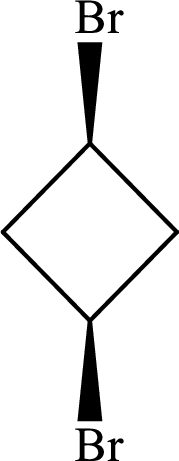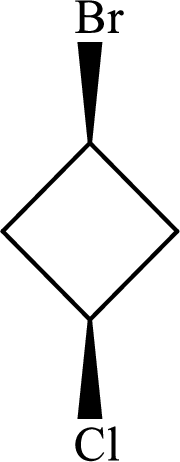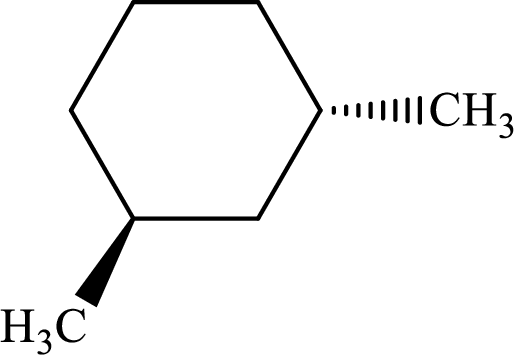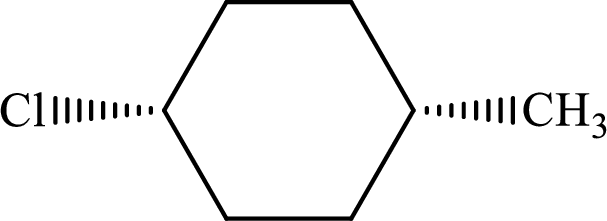
GENERAL,ORGANIC,+BIOCHEMISTRY
10th Edition
ISBN: 9781260148954
Author: Denniston
Publisher: RENT MCG
expand_more
expand_more
format_list_bulleted
Concept explainers
Question
Chapter 10, Problem 10.86QP
(a)
Interpretation Introduction
Interpretation:
Given cycloalkane has to be named using

Concept Introduction:
IUPAC rules for naming cycloalkanes:
A common nomenclature of naming organic compounds has been developed by IUPAC. By usage of this nomenclature or rules, memorizing of names of organic compounds is not necessary.
- The number of carbon atoms present in the ring is counted and the name of the
alkane that has the same number of carbon atoms is given by adding prefix “cyclo-” to the alkane name. - If the ring is substituted, then the names of the group or atoms have to be placed before the name of cycloalkane. If only one substituent is present, then number is not required.
- If the ring contains more than one substituent, then the numbers has to be used in a way that it gives the lowest position for the substituents.
(b)
Interpretation Introduction
Interpretation:
Given cycloalkane has to be named using IUPAC nomenclature.

Concept Introduction:
Refer part (a).
(c)
Interpretation Introduction
Interpretation:
Given cycloalkane has to be named using IUPAC nomenclature.

Concept Introduction:
Refer part (a).
(d)
Interpretation Introduction
Interpretation:
Given cycloalkane has to be named using IUPAC nomenclature.

Concept Introduction:
Refer part (a).
Expert Solution & Answer
Want to see the full answer?
Check out a sample textbook solution
Students have asked these similar questions
Indicate the formula of the compound, that is the result of the N-
alquilación (nucleofílic substitution), in which an additional lateral
chain was formed (NH-CH2-COOMe).
F3C.
CF3
NH
NH2
Br о
OMe
K2CO3, DABCO, DMF
Identify the mechanism through which the following reaction will proceed and draw the major product.
Part 1 of 2
Br
KOH
EtOH
Through which mechanism will the reaction proceed? Select the single best answer.
E1
E2
neither
Part: 1/2
Part 2 of 2
Draw the major product formed as a result of the reaction.
Click and drag to start drawing a
structure.
X
What is single-point calibration? Provide an example.
Chapter 10 Solutions
GENERAL,ORGANIC,+BIOCHEMISTRY
Ch. 10.1 - Prob. 10.1QCh. 10.1 - Prob. 10.2QCh. 10.2 - Prob. 10.3QCh. 10.2 - Prob. 10.4QCh. 10.3 - Prob. 10.1PPCh. 10.3 - Prob. 10.5QCh. 10.3 - Prob. 10.6QCh. 10.3 - Prob. 10.2PPCh. 10.3 - Prob. 10.3PPCh. 10.3 - Heptane is a very poor fuel and is given a zero on...
Ch. 10.4 - Name each of the following cycloalkanes using...Ch. 10.4 - Prob. 10.6PPCh. 10.4 - Prob. 10.7PPCh. 10.6 - Write a balanced equation for the complete...Ch. 10.6 - Write a balanced equation for each of the...Ch. 10.6 - Prob. 10.8QCh. 10 - Prob. 10.9QPCh. 10 - Prob. 10.10QPCh. 10 - Prob. 10.12QPCh. 10 - Prob. 10.13QPCh. 10 - Prob. 10.14QPCh. 10 - Prob. 10.15QPCh. 10 - Prob. 10.16QPCh. 10 - Prob. 10.17QPCh. 10 - Prob. 10.18QPCh. 10 - Prob. 10.19QPCh. 10 - Prob. 10.20QPCh. 10 - Prob. 10.21QPCh. 10 - Describe the major differences between ionic and...Ch. 10 - For centuries, fishermen have used shark liver oil...Ch. 10 - Prob. 10.24QPCh. 10 - Prob. 10.25QPCh. 10 - Prob. 10.26QPCh. 10 - Prob. 10.27QPCh. 10 - Prob. 10.28QPCh. 10 - Prob. 10.29QPCh. 10 - Prob. 10.30QPCh. 10 - Prob. 10.31QPCh. 10 - Prob. 10.32QPCh. 10 - Prob. 10.33QPCh. 10 - Prob. 10.34QPCh. 10 - Prob. 10.35QPCh. 10 - Prob. 10.36QPCh. 10 - Prob. 10.37QPCh. 10 - Prob. 10.38QPCh. 10 - Prob. 10.39QPCh. 10 - Prob. 10.40QPCh. 10 - Prob. 10.41QPCh. 10 - Prob. 10.42QPCh. 10 - Prob. 10.43QPCh. 10 - Prob. 10.44QPCh. 10 - Prob. 10.45QPCh. 10 - Prob. 10.46QPCh. 10 - Prob. 10.47QPCh. 10 - Prob. 10.48QPCh. 10 - Prob. 10.49QPCh. 10 - Prob. 10.50QPCh. 10 - Prob. 10.51QPCh. 10 - Prob. 10.52QPCh. 10 - Prob. 10.53QPCh. 10 - Prob. 10.54QPCh. 10 - Prob. 10.55QPCh. 10 - Prob. 10.56QPCh. 10 - Prob. 10.57QPCh. 10 - Prob. 10.58QPCh. 10 - Prob. 10.59QPCh. 10 - Prob. 10.60QPCh. 10 - Prob. 10.61QPCh. 10 - Prob. 10.62QPCh. 10 - Prob. 10.63QPCh. 10 - Prob. 10.64QPCh. 10 - Prob. 10.65QPCh. 10 - Prob. 10.66QPCh. 10 - Prob. 10.67QPCh. 10 - Prob. 10.68QPCh. 10 - Prob. 10.69QPCh. 10 - Prob. 10.70QPCh. 10 - Prob. 10.71QPCh. 10 - Prob. 10.72QPCh. 10 - Prob. 10.73QPCh. 10 - Prob. 10.74QPCh. 10 - Prob. 10.75QPCh. 10 - Prob. 10.76QPCh. 10 - Are the following names correct or incorrect? If...Ch. 10 - In your own words, describe the steps used to name...Ch. 10 - Draw the structures of the following compounds....Ch. 10 - Prob. 10.80QPCh. 10 - Prob. 10.81QPCh. 10 - Prob. 10.82QPCh. 10 - Prob. 10.83QPCh. 10 - Prob. 10.84QPCh. 10 - Prob. 10.85QPCh. 10 - Prob. 10.86QPCh. 10 - Prob. 10.87QPCh. 10 - Draw each of the following...Ch. 10 - Prob. 10.89QPCh. 10 - Prob. 10.90QPCh. 10 - Which of the following names are correct and which...Ch. 10 - Which of the following names are correct and which...Ch. 10 - Prob. 10.93QPCh. 10 - Prob. 10.94QPCh. 10 - Prob. 10.95QPCh. 10 - Prob. 10.96QPCh. 10 - What are conformational isomers?
Ch. 10 - Prob. 10.98QPCh. 10 - Make a model of cyclohexane and compare the boat...Ch. 10 - Prob. 10.100QPCh. 10 - Prob. 10.101QPCh. 10 - Prob. 10.102QPCh. 10 - Prob. 10.103QPCh. 10 - Prob. 10.104QPCh. 10 - Prob. 10.105QPCh. 10 - Prob. 10.106QPCh. 10 - Prob. 10.107QPCh. 10 - Prob. 10.108QPCh. 10 - Prob. 10.109QPCh. 10 - Prob. 10.110QPCh. 10 - Prob. 10.111QPCh. 10 - Prob. 10.112QPCh. 10 - Prob. 1MCPCh. 10 - Prob. 2MCPCh. 10 - Prob. 3MCPCh. 10 - Indicate which of the following are true of...Ch. 10 - Prob. 7MCPCh. 10 - Prob. 8MCPCh. 10 - Prob. 9MCPCh. 10 - Prob. 10MCP
Knowledge Booster
Learn more about
Need a deep-dive on the concept behind this application? Look no further. Learn more about this topic, chemistry and related others by exploring similar questions and additional content below.Similar questions
- Draw the major product formed via an E1 pathway.arrow_forwardPart 9 of 9 Consider the products for the reaction. Identify the major and minor products. HO Cl The E stereoisomer is the major product and the Z stereoisomer is the minor product ▼ S major product minor productarrow_forwardConsider the reactants below. Answer the following questions about the reaction mechanism and products. HO Clarrow_forward
- julietteyep@gmail.com X YSCU Grades for Juliette L Turner: Orc X 199 A ALEKS - Juliette Turner - Modul X A ALEKS - Juliette Turner - Modul x G butane newman projection - Gox + www-awa.aleks.com/alekscgi/x/Isl.exe/10_u-IgNslkr7j8P3jH-IBxzaplnN4HsoQggFsejpgqKoyrQrB2dKVAN-BcZvcye0LYa6eXZ8d4vVr8Nc1GZqko5mtw-d1MkNcNzzwZsLf2Tu9_V817y?10Bw7QYjlb il Scribbr citation APA SCU email Student Portal | Main Ryker-Learning WCU-PHARM D MySCU YSCU Canvas- SCU Module 4: Homework (Ch 9-10) Question 28 of 30 (1 point) | Question Attempt: 1 of Unlimited H₂SO heat OH The mechanism of this reaction involves two carbocation intermediates, A and B. Part 1 of 2 KHSO 4 rearrangement A heat B H₂O 2 OH Draw the structure of A. Check Search #t m Save For Later Juliet Submit Assignm 2025 McGraw Hill LLC. All Rights Reserved. Terms of Use | Privacy Center | Accessarrow_forwardThe electrons flow from the electron-rich atoms of the nucleophile to the electrons poor atoms of the alkyl halide. Identify the electron rich in the nucleophile. Enter the element symbol only, do not include any changes.arrow_forwardHello, I am doing a court case analysis in my Analytical Chemistry course. The case is about a dog napping and my role is prosecution of the defendant. I am tasked in the Area of Expertise in Neutron Activation and Isotopic Analysis. Attached is the following case study reading of my area of expertise! The landscaping stone was not particularly distinctive in its decoration but matched both the color and pattern of the Fluential’s landscaping stone as well as the stone in the back of the recovered vehicle. Further analysis of the stone was done using a technique called instrumental neutron activation analysis. (Proceed to Neutron Activation data) Photo Notes: Landscaping stone recovered in vehicle. Stone at Fluential’s home is similar inappearance. Finally, the white paint on the brick was analyzed using stable isotope analysis. The brick recovered at the scene had smeared white paint on it. A couple of pieces of brick in the back of the car had white paint on them. They…arrow_forward
- What is the product of the reaction? F3C. CF3 OMe NaOH / H₂Oarrow_forwardWhat would you expect to be the major product obtained from the following reaction? Please explain what is happening here. Provide a detailed explanation and a drawing showing how the reaction occurs. The correct answer to this question is V.arrow_forwardPlease answer the question for the reactions, thank youarrow_forward
arrow_back_ios
SEE MORE QUESTIONS
arrow_forward_ios
Recommended textbooks for you
 ChemistryChemistryISBN:9781305957404Author:Steven S. Zumdahl, Susan A. Zumdahl, Donald J. DeCostePublisher:Cengage Learning
ChemistryChemistryISBN:9781305957404Author:Steven S. Zumdahl, Susan A. Zumdahl, Donald J. DeCostePublisher:Cengage Learning ChemistryChemistryISBN:9781259911156Author:Raymond Chang Dr., Jason Overby ProfessorPublisher:McGraw-Hill Education
ChemistryChemistryISBN:9781259911156Author:Raymond Chang Dr., Jason Overby ProfessorPublisher:McGraw-Hill Education Principles of Instrumental AnalysisChemistryISBN:9781305577213Author:Douglas A. Skoog, F. James Holler, Stanley R. CrouchPublisher:Cengage Learning
Principles of Instrumental AnalysisChemistryISBN:9781305577213Author:Douglas A. Skoog, F. James Holler, Stanley R. CrouchPublisher:Cengage Learning Organic ChemistryChemistryISBN:9780078021558Author:Janice Gorzynski Smith Dr.Publisher:McGraw-Hill Education
Organic ChemistryChemistryISBN:9780078021558Author:Janice Gorzynski Smith Dr.Publisher:McGraw-Hill Education Chemistry: Principles and ReactionsChemistryISBN:9781305079373Author:William L. Masterton, Cecile N. HurleyPublisher:Cengage Learning
Chemistry: Principles and ReactionsChemistryISBN:9781305079373Author:William L. Masterton, Cecile N. HurleyPublisher:Cengage Learning Elementary Principles of Chemical Processes, Bind...ChemistryISBN:9781118431221Author:Richard M. Felder, Ronald W. Rousseau, Lisa G. BullardPublisher:WILEY
Elementary Principles of Chemical Processes, Bind...ChemistryISBN:9781118431221Author:Richard M. Felder, Ronald W. Rousseau, Lisa G. BullardPublisher:WILEY

Chemistry
Chemistry
ISBN:9781305957404
Author:Steven S. Zumdahl, Susan A. Zumdahl, Donald J. DeCoste
Publisher:Cengage Learning

Chemistry
Chemistry
ISBN:9781259911156
Author:Raymond Chang Dr., Jason Overby Professor
Publisher:McGraw-Hill Education

Principles of Instrumental Analysis
Chemistry
ISBN:9781305577213
Author:Douglas A. Skoog, F. James Holler, Stanley R. Crouch
Publisher:Cengage Learning

Organic Chemistry
Chemistry
ISBN:9780078021558
Author:Janice Gorzynski Smith Dr.
Publisher:McGraw-Hill Education

Chemistry: Principles and Reactions
Chemistry
ISBN:9781305079373
Author:William L. Masterton, Cecile N. Hurley
Publisher:Cengage Learning

Elementary Principles of Chemical Processes, Bind...
Chemistry
ISBN:9781118431221
Author:Richard M. Felder, Ronald W. Rousseau, Lisa G. Bullard
Publisher:WILEY
Chapter 4 Alkanes and Cycloalkanes Lesson 2; Author: Linda Hanson;https://www.youtube.com/watch?v=AL_CM_Btef4;License: Standard YouTube License, CC-BY
Chapter 4 Alkanes and Cycloalkanes Lesson 1; Author: Linda Hanson;https://www.youtube.com/watch?v=PPIa6EHJMJw;License: Standard Youtube License